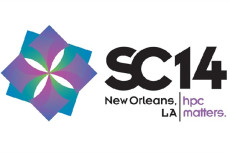SC14 DOE Booth Presentations by NERSC, Berkeley Lab Staff
November 17, 2014
At the DOE booth (#1939) during the SC14 conference this week, Berkeley Lab staff will give featured talks, present demonstrations and host roundtable discussions.
Featured Talks
“How Does the Internet Get Under the Ocean? Building ESnet’s Transatlantic Extension,” by Greg Bell, ESnet, 3-3:30 p.m., Tuesday, Nov. 18.
Abstract: The Department of Energy’s Energy Sciences Network, or ESnet, is deploying three 100 gigabit-per-second (Gbps) trans-Atlantic links from the U.S. to Europe, giving researchers at American universities and national laboratories the fastest possible access to scientific data from the Large Hadron Collider (LHC) and other sites in Europe. ESnet’s new connections to Europe, which will also include a 40 Gbps link, will replace about a dozen 10 Gbps connections, streamlining the infrastructure and providing nearly three times the overall bandwidth at a lower cost. The project, known as the ESnet European Extension, or EEX, will produce an end-to-end 100 Gbps connection between research institutions in the U.S. and experiment facilities like the Large Hadron Collider (LHC) in Switzerland.
“Cori and Trinity: Stepping Stone to Exascale,” Katie Antypas, NERSC, 4:30-5:15 p.m., Tuesday, Nov. 18.
Abstract: The National Energy Research Scientific Computing (NERSC) Center at Berkeley Lab and the New Mexico Alliance for Computing at Extreme Scale (ACES) a partnership between Los Alamos and Sandia National Laboratories have both signed contracts with Cray Inc. for the next generation supercomputers to support their user community's transition to more energy efficient extreme scale computing architectures. The systems were procured as part of the partnership between the DOE's Office of Science and National Nuclear Security Administration. Both systems will feature the Intel Knights Landing manycore processor and the Cray Aries high bandwidth interconnect. The NERSC system, named Cori, after Nobel Laureate Gerty Cori, will support NERSC's 5500 science users and be delivered in mid-2016. The NNSA supercomputer, called Trinity, will advance the mission for the Stockpile Stewardship Program as part of the NNSA Advanced Simulation and Computing (ASC) Program. (This is a joint presentation with Manuel Vigil of Los Alamos National Laboratory.)
“CAMERA: the Center for Advanced Mathematics for Energy Research Applications” by James Sethian, CRD, 12:30-1:00 p.m. Wednesday, Nov. 19.
Abstract: The Center for Advanced Mathematics for Energy Research Applications (CAMERA) is an integrated, cross disciplinary center aimed at inventing, developing, and delivering the fundamental new mathematics required to capitalize on experimental investigations at DOE User Facilities. Fundamental computational methods are needed to extract information from murky data, interpret experimental results, and provide on-demand analysis as information is being generated. Advanced algorithms can reconstruct complex materials analyzed by evermore powerful imaging, examine candidate materials that are too expensive and time-consuming to manufacture, rapidly find optimal solutions to energy-related challenges, and suggest new experiments for discovery science. In this talk, we will discuss the organization and structure of CAMERA, introduce the current main focus areas, and describe case studies of end-to-end projects, from fundamental mathematics through delivered web-driven software.
Science Data Pilot Projects (more)
“X-rays and Supercomputing – Opening New Frontiers in Photon Science” by Craig Tull, CRD, 10:30-11 a.m. Tuesday, Nov. 18. This talk is one of a series on DOE’s Science Data Pilot Projects.
“Investigating Organic PhotoVoltaics in Real-Time With an ASCR Super-Facility” by Craig Tull, CRD, 11-11:30 a.m. Tuesday, Nov. 18. This talk is one of a series on DOE’s Science Data Pilot Projects.
“EXDAC – EXtreme Data Analysis for Cosmology” by Peter Nugent, CRD, 2:30-3:15 p.m. Wednesday, Nov. 19. This talk is one of a series on DOE’s Science Data Pilot Projects.
Roundtable Discussions
“Cori and Trinity: Stepping Stone to Exascale,” by Katie Antypas, NERSC, 5:15-6 p.m., Tuesday, Nov. 18. Co-hosted by Manuel Vigil of LANL, this is a follow-on discussion to their featured talk.
“High Performance Parallel I/O”: meet the authors – Prabhat and Quincey,” Prabhat, NERSC and Quincey Koziol, HDF Group, 5:15-6 p.m., Tuesday, Nov. 18.
“EXDAC – EXtreme Data Analysis for Cosmology” co-hosted by Peter Nugent, CRD, 5-6 p.m. Wednesday, Nov. 19. This is a follow-on discussion to their featured talk and demonstration.
Demonstrations
“OpenSoC Fabric: An Open-Source Parametrized Network Generation Tool” by David Donofrio, CRD, 11 a.m.-12 p.m., Tuesday and Wednesday, Nov. 18-19, and 10-11 a.m. Thursday, Nov. 20.
“Real Time Processing of Human and Rodent Neurological Recording Data” by David Donofrio, CRD, 2-3 p.m. Wednesday, Nov. 19.
“EXDAC – EXtreme Data Analysis for Cosmology” co-led by by Peter Nugent, CRD, 3-4 p.m. Wednesday, Nov. 19. This demonstration follows a featured talk on this topic and is followed by a roundtable discussion.
About NERSC and Berkeley Lab
The National Energy Research Scientific Computing Center (NERSC) is a U.S. Department of Energy Office of Science User Facility that serves as the primary high performance computing center for scientific research sponsored by the Office of Science. Located at Lawrence Berkeley National Laboratory, NERSC serves almost 10,000 scientists at national laboratories and universities researching a wide range of problems in climate, fusion energy, materials science, physics, chemistry, computational biology, and other disciplines. Berkeley Lab is a DOE national laboratory located in Berkeley, California. It conducts unclassified scientific research and is managed by the University of California for the U.S. Department of Energy. »Learn more about computing sciences at Berkeley Lab.








